Importing goods is a complex process that requires the preparation and presentation of various documents. These documents are essential to comply with the customs regulations and legal requirements of the importing country. In this article, we will review the main documents required to import goods, with details of their usefulness.
The Incoterms® chosen determine whether the seller or the buyer is responsible for import customs clearance in the destination country, and for providing the necessary documents.
Here is a list of the documents that the competent authorities in the destination country may require
Proforma and commercial invoices
For each shipment, the supplier prepares and sends a proforma invoice to the buyer to confirm the details of the order and generally request a deposit payment.
In many countries, customs require the presentation of pro forma invoices, which attest to the value of the shipment. This makes it easier to set customs duties. The document is similar in form to a final invoice, but does not include a payment obligation.
What is the difference between a proforma invoice and a commercial invoice?
By definition, a proforma invoice is a formal invoice. It therefore resembles a final invoice. A proforma invoice is a provisional document that details the price of the goods and the general conditions of sale, and reflects the actual value of the goods before the sale takes place. In this regard, it is more like an estimate than an invoice. It is a purely informative document with no accounting or legal value. A proforma invoice is required when exporting goods outside the EU, if they are not intended for sale. It is mainly used in the following cases:
- When the sale has not yet taken place;
- To send gifts;
- To send samples;
- For the return of goods to the supplier.
Who issues a commercial invoice?
The seller or exporter issues the commercial invoice as proof of sale.
What information should be included on the commercial invoice?
The commercial invoice should contain at least the following information:
- the name and address of the exporter and the importer;
- invoice issue date;
- invoice number;
- a description of the goods sold;
- the unit of measurement;
- the quantity of goods sold;
- the HS code of the goods;
- the unit value;
- the total value of the sale;
- the total value of the invoice and the currency used for payment;
- the payment terms, including payment method, date and any discounts;
- The delivery terms and Incoterms® used;
- the means of transport.
The following information should be included on your invoice:
- for deliveries of goods, the words "Exempt - Article 146 Directive 2006/112/EC";
- for your services, the words "No EU VAT - article 44 Directive 2006/112/CE".
How should I fill in the invoice?
The commercial invoice can be filled in electronically in accordance with the European digital invoicing rules. These rules are mandatory for business-to-business transactions.
Where should I put the commercial invoice when shipping?
The commercial invoice should always accompany the goods. If you are sending your goods by post, you will need to present two copies along with the original commercial invoice. The three copies of the commercial invoice should be placed in a transparent envelope and attached to the parcel.
Packing list
- the number of pallets, if applicable
- the number of packages per pallet or the total number of packages
- the number of items per package
- the gross and net weight and volume of each package and/or pallet
- the number assigned to each package
- the contents of each package
- the product references and their brand
It enables the various parties involved (shippers, carriers, customs inspectors, warehousemen, customers, etc.) to check the conformity of the goods shipped on the basis of the invoice issued. It should be put in the transparent envelope together with the copies of the proforma or commercial invoices.
Import licence
The import of certain categories of goods, or goods from certain countries, may be subject to restrictions or authorisation. The import licence is a document that the operator in charge of importing should obtain in these cases.
Here are some examples of products subject to restrictive measures:
- Medicine
- Agricultural products
- Chemicals
- Cultural goods
- Weapons
- Textile and clothing products
- Plants or products containing plant substances
- etc.
To check whether or not your products require an import licence, once they have been classified, please consult the TARIC database.
Certificates
Certificates show that your goods comply with the safety, health, labelling and packaging regulations applicable in the country of destination.
You can check with the importer or regional export promotion organisations (FIT/AWEX) whether a certificate is required for the export of a specific product.
Certificate of origin
The certificate of origin is a document that establishes the product's "nationality". You need it to export outside the European Union (EU). The certificate facilitates import into the country of destination. If there is a trade agreement between the EU and your export destination, and you can prove that your products have been manufactured in one of the partner countries of the agreement, you will benefit from preferential treatment thanks to the so-called "preferential origin". As a basic rule, a product always retains its origin until it has been sufficiently processed. To clarify this point, rules of origin are laid down in a protocol of origin included in each free trade agreement. The content of this protocol varies from one free trade agreement to another. An exported product may therefore obtain preferential origin under one agreement but not under another. To help companies, the European Commission has developed a self-assessment tool called ROSA.
The certificate of origin is issued in Belgium by:
Who can help me ?




